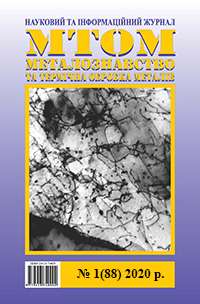VACANCIES AS A METAL ALLOYING ELEMENT
DOI:
https://doi.org/10.30838/J.PMHTM.2413.260222.48.632Keywords:
vacancy hardening, hydrostatic compression, dislocation substructure, deformation-heat treatment, nonequilibrium concentration of vacancies, cyclic deformation, high-speed recrystallization heatingAbstract
Purpose. The study and development of methods for a new type of environmentally friendly alloying of metals with a controlled nonequilibrium concentration of vacancies. Methodology. System analysis of methods of alloying metals with a nonequilibrium concentration of vacancies and the mechanisms of the influence of this alloying on the structure and properties of metals. Results. The theoretical foundations of doping with a nonequilibrium concentration of vacancies by means of vacancy hardening, hydrostatic compression, cyclic deformation, special deformation-heat treatment according to the type of high-speed recrystallization annealing of cold-deformed metal, as well as a combination of these methods are developed. Originality. The processes that result in the interaction of vacancies with moving dislocations, which significantly changes the trajectories of the dislocations and forms a dislocation substructure with special quasi-equilibrium boundaries that are close in properties to the boundaries formed during high-temperature thermomechanical processing. Practical value. The principles of regulating the parameters of vacancy doping, ensuring its effectiveness and the controlled parameters of doping methods, are indicated.
References
Vladimirov V.I. Fizicheskaya teoriya prochnosti I plastichnosti metallov [Physical Theory of Strength and Plasticity of Metals]. Leningrad : LPI, 1975, 224 p. (in Russian).
Physical metallurgy. Ed. by R.W.Cahn, chapters XIII−XX. North-Holland Publishing Co, Amsterdam, 1965.
Gabidullin R.M. and Kolachev B.A. Izvestiya VUZov. Zvetnaya metallurgiya [Non-ferrous metallurgy. University News]. 1976, no. 4, pp. 87−91. (in Russian).
Kamishanchenko N.V. Vliyanie mechaniko-termicheskogo vozdeystviya na structure I svoystva zakalennih chistyh metallov [The influence of mechanical and thermal effects on the structure and properties of hardened pure metals]. Belhorod, 1984, 197 p.; Dep.VINITI № 5979-84. (in Russian).
Herzberg R.V. Deformaziya i mechanika razrusheniya konstrukzionnih materialov [Deformation and fracture mechanics of structural materials]. Moscow : Metallurgiya, 1979, 576 p. (in Russian).
Kolbasnikov N.G. O roli vakansiy v formirovanii svoystv metallov [On the role of vacancies in the formation of the properties of metals]. Metally [Metals]. 1998, no. 6, pp. 80−90. (in Russian).
Gul’ Yu.P., Leschenko A.N. and Pilipchenko V.Yu. Rol’ vakansionnoy zakalki pri termoplasticheskom uprochnenii staley austenitnogo klassa [The role of vacancy hardening in thermoplastic hardening of austenitic steels]. Metally [Metals]. 1990, no. 4, pp.77−83. (in Russian).
Fridel’ G. Dislokazii [ Dislocations]. Moscow : Mir, 1967, 644 p. (in Russian).
Buren Van. Defekty v kristallah [Crystal defects]. Moscow : Izdat. Inostr. lit., 1962, 574 p. (in Russian).
Gul’ Yu.P., Chmeleva V.S. and Kirichenko V.V. Sovremenniy aspekty zakalochnouo ohlagdeniya staly [Modern aspects of the quench cooling of steel]. MiTOM [Metal Science and Heat Treatment of Metals]. 1989, no. 9, pp. 2−6. (in Russian).
Takamura D.I. Tochechnie defekty [Point defects]. Ed. by R.U.Kana. Fizicheskoe metallovedenie [Physical metallurgy]. Moscow : Mir, 1968, vol. 3, pp.87−105. (in Russian).
Honikomb R. Plasticheskaya deformaciya metallov [Plastic deformation of metals]. Moscow : Mir,1972, 408 p. (in Russian).
Hirt Dg. and Lote I. Teoriya dislokaziy [Dislocation theory]. Moscow : Atomizdat, 1972, 432 p. (in Russian).
Mak Lin D. Mechanicheskie svoystva metallov [The mechanical properties of metals]. Moscow : Metallurgizdat, 1965, 432 p. (in Russian).
Damask A. and Dins Dg. Tochechnie defekty v metallah [Point defects in metals]. Moscow : Mir, 1966, 291 p. (in Russian).
Blanter M.E. and Gorelik S.S. Obrazovanie vakansiy pri rekristallizacii [Vacancy formation during recrystallization]. Izvestiya AN USSR. Metally [News of the USSR Academy of Sciences. Metals]. 1982, no. 2, pp. 90−93. (in Russian).
Downloads
Published
Issue
Section
License
Authors that are published in this journal agree to follow the conditions:
Authors reserve the right to the authorship of his work and cede the right to the journal of first publication of this work on conditions of the license under the Creative Commons Attribution License, which allows others to distribute it freely with the obligatory reference to the author of the original work and the first publication of the work in this journal.

